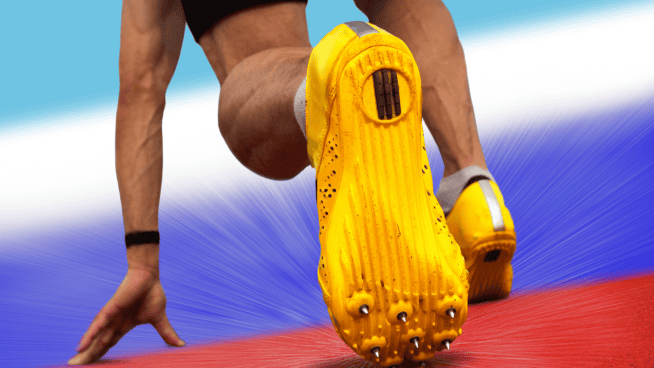3 Special Strength Exercises for Better Jumping and Sprinting
When it comes to being a better athlete, we often want one (or both) of two key qualities:
- To run faster
- To jump higher
Although raw power is great, there is a level of “touch” specific to maximally develop jumping and sprinting. The best way to improve them tends to be actually doing them in some form or fashion.
Although the weight room isn’t as specific as doing the actual skills, there are some methods of training in the weight room that can bring greater transfer to faster sprints and better jumps by taking advantage of muscle physiology, biomechanics and the kinetic chain.
In other words, there are more advanced ways to use the weight room to improve the general human abilities that lead to higher jumps and faster sprints versus sticking with just the traditional Squats and Deadlifts (not that those methods can’t be effective, but methods exist that have more specific means by which to direct the strength gains).
Three “special” strength exercises I really enjoy using with many athletes are:
- Weck Method 45 Trap Bar Deadlifts
- Oscillatory Isometric Split Squats
- Single-Leg Bounds
These can really help those with previously stagnant sprinting and jumping levels. In my book Speed Strength, I give practical advice on how they all fit into my performance training programs, alongside many other specific methods.
Let’s take a closer look at these three unique weight room movements and the impact they can have on sprinting and jumping.
1. Weck Method 45 Trap Bar Deadlifts
If you want to up your game in athletic weightlifting, find more ways to integrate the lower leg.
Many of us remember strength shoes. Although I’ve seen work that claimed that a plyometric workout done with and without strength shoes gets the same results, research by Voison et al. (2019) showed that performing a plyometric program wearing footwear that left the heel floating off the ground could yield superior results (+3 inches over control group in eight weeks) as well as superior improvements in agility times compared to a group who performed the same program with standard footwear. There is something powerful that exists in overloading the ball of the foot in training.
In the weight room, athletes are often trained to the point where their hips and back become very strong. Their knees may become somewhat stronger. Yet the feet, Achilles tendons and calves are generally ignored. In this typical scenario, an athlete gets stronger at things like Cleans, Squats and Deadlifts, and the primary adaptations are increased strength and mass in glutes and spinal erectors, and perhaps more muscle in the legs for those athletes who connect into their legs well (not all athletes do, however, such as those who are very hinge dominant).
The problem is that the feet and lower legs do not gain a proportional amount of strength versus other muscle groups. I do understand that the feet get loaded heavily just by playing one’s sport, but then again, so do the knees and hips. It is important to consider the role of the foot in training.
To this end, barbell work, specifically Trap Bar Deadlifts, can be a great way to create lifting scenarios where an athlete must favor the ball of the foot to leave no weak link in the kinetic chain. Two of my favorite ways to do this are the Weck Method 45 Trap Bar Deadlift and “Floating Heel” Trap Bar Deadlifts.
The Weck Method 45 Deadlift was created by David Weck and is one of my favorite lower-body training exercises.
I’ve seen athletes who were previously stagnant on things like vertical jump, even after increasing their Squat significantly, tack on a 4-inch increase in a short period of time using the Weck 45 Deadlift as their primary lower-body exercise.
It works the kinetic chain in a more natural manner in terms of incorporating the feet and the rotational nature of the glutes. To perform it, you’ll center your feet with all pressure on the ball of the 4th and 5th metatarsal (under the pinkie toe). The heels are lifted off the ground by a few centimeters. Keeping the shins and torso at a congruent angle, athletes will lift the bar off the floor. This exercise is often met by feeling a ton of tension running through the lower leg, as well as a good feeling of the glutes working powerfully.
This is a great basic strength movement that leaves fewer weak links in the kinetic chain versus standard methods of deadlifting or even squatting. This type of Deadlift can also be done by simply putting a couple of 5- or 10-pound plates on the floor in the middle of a trap bar, standing on them so your heels are “floating” off the ground, then executing the lift in the same manner as Weck advises.
2. Oscillatory Isometric Split Squat
I’ve written about the Oscillatory Isometric Split Squat in the past as a fantastic method to improve sprinting speed. It’s one of the few methods that can be done in the weight room that can actually match some of the angular velocity and contraction-relaxation cycles of sprinting. Traditional lifts, even Olympic lifts, tend to not even come close to the angular hip velocities that athletes hit when sprinting.
Being a good sprinter and jumper not only relies on being able to turn a lot of muscles on in a short period of time, but also being able to turn a lot of muscles off rapidly. In fact, Russian research showed that the difference between lower level sprinters and higher ones was not maximal muscular force, but rather the speed of relaxation in the muscle! The most elite sprinters could relax their muscles significantly faster than sub-elite sprinters.
To perform the Oscillatory Isometric Split Squat, you’ll set up in a Bulgarian Split Squat position and come to a point where the front thigh is about parallel to the ground.
From here consciously put maximal tension into the front leg glute and quad for a second and then relax it completely, dropping down to the bottom of the squat. Upon relaxing, you should find that you “bounce” out of the bottom without putting conscious effort into it. This is “static spring” in action. Muscles contract powerfully, then relax instantly. The bounce out of the bottom is subconscious and powered by the stretch shortening cycle, just like sprinting and jumping.
3. Single-Leg Bounding
The last exercise on this list isn’t truly a “weight room” exercise in the traditional sense, but it is an exercise that can be done in the vast majority of weight room spaces.
If an athlete can single-leg bound well, which is often determined by whether they can get the heel of the bounding leg up toward the butt in the course of bounding (see video below), this tells me that they can do a lot of things well, including:
- Preactivate their feet and lower leg muscles to store and release kinetic energy.
- Lock and unlock the knee to let the foot move in the air to reposition itself.
- Use their arms in conjunction with the legs to help the repositioning of the swing leg.
In other words, people who can bound on a single leg tend to be great athletes! They have a lot of movement options and can move elastically, engaging the fascial system and connecting their arms and legs. Historically, track coaches have used tests such as 30 meters of bounding on a single leg from a flat start as a test of elastic power and potential.
Below is a great video demonstrating an excellent technique in a single-leg bound. Notice the high recovery of the foot in the bounding leg, as well as how the athlete uses the arm on the bounding leg side (works the elbow out to the side).
Athletes who can bound in this manner are very versatile athletically, and this represents the power of events like the triple jump in track and field.
If you’re not familiar with Mike Conley Sr., he’s the father of NBA point guard Mike Conley Jr. and a former world record holder in the triple jump. He often participated in celebrity slam dunk competitions during his competitive track and field days, and his bounding ability made for some extraordinary maneuvers:
Not bad for a guy who’s just a hair over 6 feet tall.
So there you have three “special” strength exercises that can help your gym time connect more directly to athleticism. Hopefully, they’ll also help get your wheels turning in regards to how to make any movement more athletic. Just loading more weight on the bar for traditional movements doesn’t require much thought. Learning about the human body and its abilities is a more complex but highly rewarding journey as we work toward being the best athletic version of ourselves we can be.
Photo Credit: simonkr/iStock
READ MORE:
RECOMMENDED FOR YOU
MOST POPULAR
3 Special Strength Exercises for Better Jumping and Sprinting
When it comes to being a better athlete, we often want one (or both) of two key qualities:
- To run faster
- To jump higher
Although raw power is great, there is a level of “touch” specific to maximally develop jumping and sprinting. The best way to improve them tends to be actually doing them in some form or fashion.
Although the weight room isn’t as specific as doing the actual skills, there are some methods of training in the weight room that can bring greater transfer to faster sprints and better jumps by taking advantage of muscle physiology, biomechanics and the kinetic chain.
In other words, there are more advanced ways to use the weight room to improve the general human abilities that lead to higher jumps and faster sprints versus sticking with just the traditional Squats and Deadlifts (not that those methods can’t be effective, but methods exist that have more specific means by which to direct the strength gains).
Three “special” strength exercises I really enjoy using with many athletes are:
- Weck Method 45 Trap Bar Deadlifts
- Oscillatory Isometric Split Squats
- Single-Leg Bounds
These can really help those with previously stagnant sprinting and jumping levels. In my book Speed Strength, I give practical advice on how they all fit into my performance training programs, alongside many other specific methods.
Let’s take a closer look at these three unique weight room movements and the impact they can have on sprinting and jumping.
1. Weck Method 45 Trap Bar Deadlifts
If you want to up your game in athletic weightlifting, find more ways to integrate the lower leg.
Many of us remember strength shoes. Although I’ve seen work that claimed that a plyometric workout done with and without strength shoes gets the same results, research by Voison et al. (2019) showed that performing a plyometric program wearing footwear that left the heel floating off the ground could yield superior results (+3 inches over control group in eight weeks) as well as superior improvements in agility times compared to a group who performed the same program with standard footwear. There is something powerful that exists in overloading the ball of the foot in training.
In the weight room, athletes are often trained to the point where their hips and back become very strong. Their knees may become somewhat stronger. Yet the feet, Achilles tendons and calves are generally ignored. In this typical scenario, an athlete gets stronger at things like Cleans, Squats and Deadlifts, and the primary adaptations are increased strength and mass in glutes and spinal erectors, and perhaps more muscle in the legs for those athletes who connect into their legs well (not all athletes do, however, such as those who are very hinge dominant).
The problem is that the feet and lower legs do not gain a proportional amount of strength versus other muscle groups. I do understand that the feet get loaded heavily just by playing one’s sport, but then again, so do the knees and hips. It is important to consider the role of the foot in training.
To this end, barbell work, specifically Trap Bar Deadlifts, can be a great way to create lifting scenarios where an athlete must favor the ball of the foot to leave no weak link in the kinetic chain. Two of my favorite ways to do this are the Weck Method 45 Trap Bar Deadlift and “Floating Heel” Trap Bar Deadlifts.
The Weck Method 45 Deadlift was created by David Weck and is one of my favorite lower-body training exercises.
I’ve seen athletes who were previously stagnant on things like vertical jump, even after increasing their Squat significantly, tack on a 4-inch increase in a short period of time using the Weck 45 Deadlift as their primary lower-body exercise.
It works the kinetic chain in a more natural manner in terms of incorporating the feet and the rotational nature of the glutes. To perform it, you’ll center your feet with all pressure on the ball of the 4th and 5th metatarsal (under the pinkie toe). The heels are lifted off the ground by a few centimeters. Keeping the shins and torso at a congruent angle, athletes will lift the bar off the floor. This exercise is often met by feeling a ton of tension running through the lower leg, as well as a good feeling of the glutes working powerfully.
This is a great basic strength movement that leaves fewer weak links in the kinetic chain versus standard methods of deadlifting or even squatting. This type of Deadlift can also be done by simply putting a couple of 5- or 10-pound plates on the floor in the middle of a trap bar, standing on them so your heels are “floating” off the ground, then executing the lift in the same manner as Weck advises.
2. Oscillatory Isometric Split Squat
I’ve written about the Oscillatory Isometric Split Squat in the past as a fantastic method to improve sprinting speed. It’s one of the few methods that can be done in the weight room that can actually match some of the angular velocity and contraction-relaxation cycles of sprinting. Traditional lifts, even Olympic lifts, tend to not even come close to the angular hip velocities that athletes hit when sprinting.
Being a good sprinter and jumper not only relies on being able to turn a lot of muscles on in a short period of time, but also being able to turn a lot of muscles off rapidly. In fact, Russian research showed that the difference between lower level sprinters and higher ones was not maximal muscular force, but rather the speed of relaxation in the muscle! The most elite sprinters could relax their muscles significantly faster than sub-elite sprinters.
To perform the Oscillatory Isometric Split Squat, you’ll set up in a Bulgarian Split Squat position and come to a point where the front thigh is about parallel to the ground.
From here consciously put maximal tension into the front leg glute and quad for a second and then relax it completely, dropping down to the bottom of the squat. Upon relaxing, you should find that you “bounce” out of the bottom without putting conscious effort into it. This is “static spring” in action. Muscles contract powerfully, then relax instantly. The bounce out of the bottom is subconscious and powered by the stretch shortening cycle, just like sprinting and jumping.
3. Single-Leg Bounding
The last exercise on this list isn’t truly a “weight room” exercise in the traditional sense, but it is an exercise that can be done in the vast majority of weight room spaces.
If an athlete can single-leg bound well, which is often determined by whether they can get the heel of the bounding leg up toward the butt in the course of bounding (see video below), this tells me that they can do a lot of things well, including:
- Preactivate their feet and lower leg muscles to store and release kinetic energy.
- Lock and unlock the knee to let the foot move in the air to reposition itself.
- Use their arms in conjunction with the legs to help the repositioning of the swing leg.
In other words, people who can bound on a single leg tend to be great athletes! They have a lot of movement options and can move elastically, engaging the fascial system and connecting their arms and legs. Historically, track coaches have used tests such as 30 meters of bounding on a single leg from a flat start as a test of elastic power and potential.
Below is a great video demonstrating an excellent technique in a single-leg bound. Notice the high recovery of the foot in the bounding leg, as well as how the athlete uses the arm on the bounding leg side (works the elbow out to the side).
Athletes who can bound in this manner are very versatile athletically, and this represents the power of events like the triple jump in track and field.
If you’re not familiar with Mike Conley Sr., he’s the father of NBA point guard Mike Conley Jr. and a former world record holder in the triple jump. He often participated in celebrity slam dunk competitions during his competitive track and field days, and his bounding ability made for some extraordinary maneuvers:
Not bad for a guy who’s just a hair over 6 feet tall.
So there you have three “special” strength exercises that can help your gym time connect more directly to athleticism. Hopefully, they’ll also help get your wheels turning in regards to how to make any movement more athletic. Just loading more weight on the bar for traditional movements doesn’t require much thought. Learning about the human body and its abilities is a more complex but highly rewarding journey as we work toward being the best athletic version of ourselves we can be.
Photo Credit: simonkr/iStock
READ MORE:










